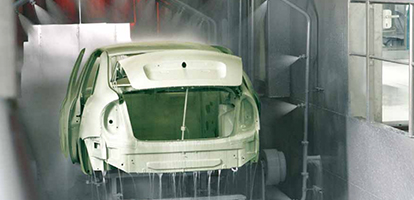

Lower costs while simultaneously increasing quality: As in any other economic sector, this maxim applies to the automotive industry as well. In order to offer customers the optimum price/performance ratio, development takes place constantly and at every level. One means for this is the automated method for electrophoretic deposition painting, so-called e-coating. The WAGO-I/O-SYSTEM 750 plays a central role.
Cathodic dip coating is an electrochemical process that basically functions as follows: By applying a continuous current between two electrodes, the charged dispersion particles, the so-called paint micelles, are attracted to the electrode with the opposite charge and migrate into a boundary layer close to the surface to be painted, where they are precipitated by a change in the pH value as a result of the electrical decomposition of the water. When the surface charge of the dispersion particles is positive, then a deposition takes place on the vehicle (acting as the cathode).
The respective anode currents, which are provided via the system rectifier, are measured via a shunt at more than 70 measurement points, using a total of 142 supply points. WAGO’s 750-469/000-003 analog voltage input modules are used, which have input range or +/1 100 mV. Two WAGO controllers form the core of these measurements using RJ-45 ETHERNET interfaces and two additional ETHERNET fieldbus couplers. Four 750-466 analog input current modules measure a current in the range from 4 to 20 mA as the equivalent of the anode voltage.
Visualization via CODESYS
The application is visualized using the Web service incorporated into the WAGO controllers and the self-generated html pages that are filed there. Each client computer in the same network can access these pages using an Internet browser, and monitor and control the process. Programming and visualization takes place in the CODESYS development environment, according to the international standard IEC 61131-3. By using the integrated visualization editor, interactive displays can be generated at low expenditures, and can be filed in the controller’s Web server to function as an HMI (human machine interface) for the operators. In addition, WAGO provides ready-made modules for non-proprietary, open-source standards, on which company-specific applications can be established.
Data Bank Supported Automation
The continuously detected measured values are constantly written to an SQL database. This automatic monitoring is the core of the improved method. The constancy and level of the current intensity is an important indicator of the quality of the paint application. The total current intensity, and thus current intervals for all systems are, however, dependent on whether the raw body is already completely submerged in the bath or not.
Previously, the point of complete submergence had to be manually observed, and the current intensities of the respective measurement points were determined using measured value switches and added to the total current intensity. This process was very time intensive and errors could creep in. Now, the stored values from the last vehicle are automatically called at the push of a button. The program also recognizes autonomously when the raw chassis is completely submerged. It automatically checks whether the summed currents that it measures lie within a defined target range. This automated process offers many advantages: The measured value, determined within a very short time frame, is more exact, the measurements are now continuous, and provide more precise results. Previously, due to the large expense, not every chassis could be monitored; now a 100 percent data acquisition is standard. Errors or failures in the transport chain are thereby recognized earlier, rejects are avoided, and a higher quality is assured. As a service to our customers, WAGO provides a large pool of ready-made function blocks for other applications, including data loggers or RFID’s. Compatibility with standard ETHERNET applications using Linux® or Windows is thereby ensured. It is also possible to transmit TCP data using MODBUS.
Flexible Control
The application, which has more than 140 measuring points, is already relatively complex. The WAGO controller has already demonstrated that it is highly flexible to use and expand, due to the multiplicity of interfaces and the large bandwidth for protocols and bus systems, and easily masters the data stream from numerous input modules. The compact design of the I/O modules, at just 12 mm installation width, was also especially advantageous in light of the number of measuring points used.
Text: Manfred Grabowski, WAGO
Photo: Eisenmann, WAGO